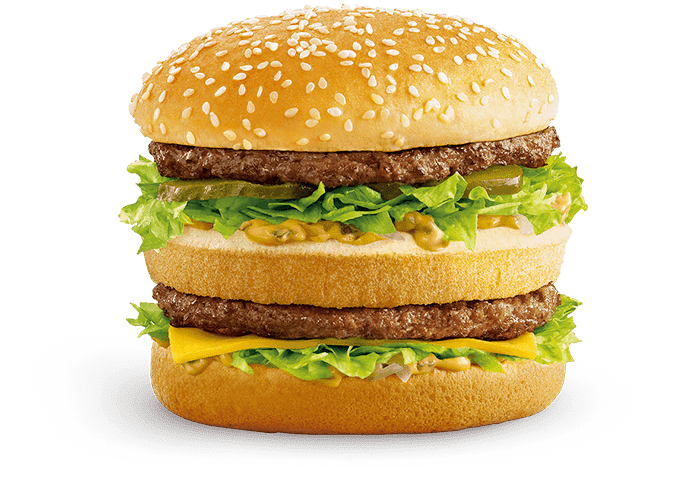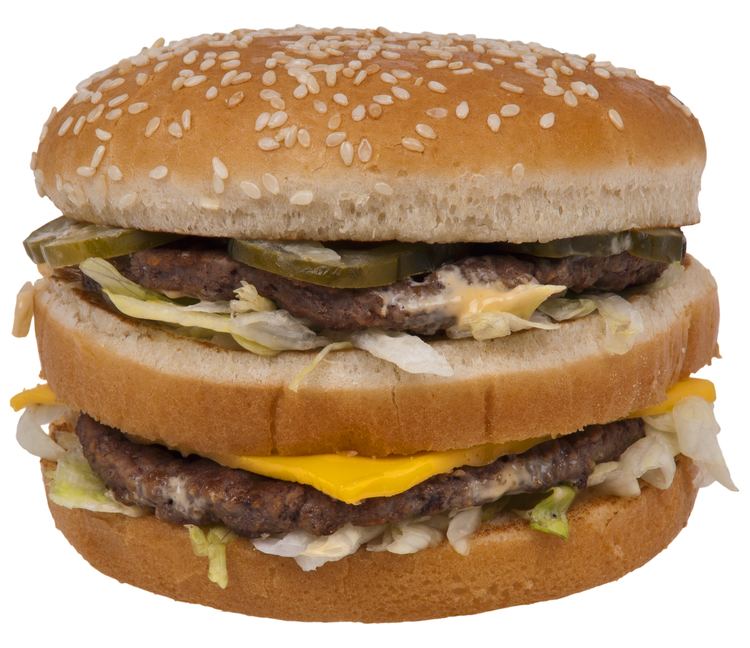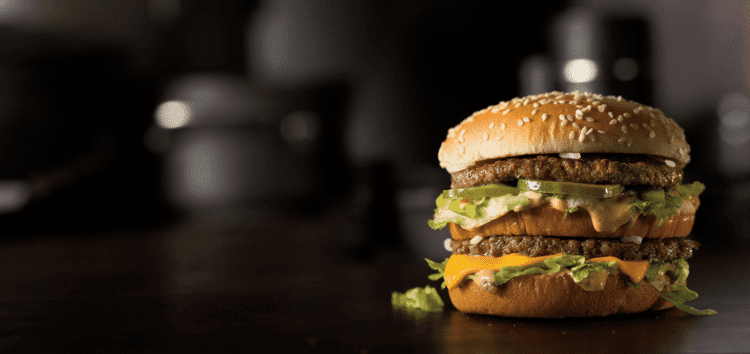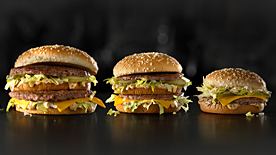Energy 550 kcal (2,300 kJ) Sugars 9 g Fat 29 g (47%) | Carbohydrates 46 g (15%) Dietary fiber 3 g (13%) Saturated 10 g (52%) | |
 | ||
Cum sa faci un hamburger big mac
The Big Mac is a hamburger sold by international fast food restaurant chain McDonald's. It was introduced in the Greater Pittsburgh area, United States, in 1967 and nationwide in 1968. It is one of the company's signature products.
Contents
- Cum sa faci un hamburger big mac
- How to make a mcdonald s big mac
- History
- Product
- Special sauce
- Advertising
- Two all beef patties slogan
- 1980s advertising
- 2005 advertising
- Variants
- McDonaldland character
- Museum
- Nutritional values per geographical location
- References

How to make a mcdonald s big mac
History

The Big Mac was created by Jim Delligatti, an early Ray Kroc franchisee, who was operating several restaurants in the Pittsburgh area. It was invented in the kitchen of Delligatti's first McDonald's franchise, located on McKnight Road in suburban Ross Township. The Big Mac had two previous names, both of which failed in the marketplace: the Aristocrat, which consumers found difficult to pronounce and understand, and Blue Ribbon Burger. The third name, Big Mac, was created by Esther Glickstein Rose, a 21-year-old advertising secretary who worked at McDonald’s corporate headquarters in Oak Brook, Illinois. The Big Mac debuted at Delligatti's Uniontown, Pennsylvania restaurant in 1967, selling for 45 cents. It was designed to compete with Big Boy restaurants' Big Boy sandwich; Eat'n Park was the Pittsburgh area's Big Boy franchisee at the time. The Big Mac proved popular, and it was added to the menu of all U.S. restaurants in 1968.
Product

The Big Mac consists of two 1.6 oz (45.4 g) 100 per cent beef patties, "special sauce" (a variant of Thousand Island dressing), iceberg lettuce, American cheese, pickles, and onions, served in a three-part sesame seed bun.

The Big Mac is known worldwide and is often used as a symbol of American capitalism. The Economist has used it as a reference point for comparing the cost of living in different countries – the Big Mac Index – as it is so widely available and is comparable across markets. This index is sometimes referred to as Burgernomics.
Special sauce
The name was popularized by a 1974 advertising campaign featuring a list of the ingredients in a Big Mac: "Two all-beef patties, special sauce, lettuce, cheese, pickles, onions – on a sesame seed bun."
Big Mac Sauce is delivered to McDonald's restaurants in sealed canisters designed by Sealright, from which it is meant to be directly dispensed using a special calibrated "sauce gun" that dispenses a specified amount of the sauce for each pull of the trigger. Its design is similar to a caulking gun.
In 2012, McDonald's admitted that "the special sauce ingredients were not really a secret" because the recipe had been available online "for years". It consists of store-bought mayonnaise, sweet pickle relish and yellow mustard whisked together with vinegar, garlic powder, onion powder and paprika.
Advertising
The earliest instances of McDonald's utilizing advertising for the sandwich were mainly print ads, and a TV ad in which Hoyt Axton sings "The Ballad of Big Mac" which aired in 1969.
Two all-beef patties slogan
The Two all-beef patties, special sauce, lettuce, cheese, pickles, onions – on a sesame seed bun concept for the jingle was created by Keith Reinhard, Chairman Emeritus of DDB Worldwide, and his creative group at Needham Harper and Steers. Originally, the ingredients appeared as a one-word heading for a McDonald's ad developed for college newspapers. The words were then set to music created by Mark Vieha, who performed the original jingle. The first run of commercials ran only a year and a half, going off the air in 1976, but its popularity remained beyond its TV life. Subsequent to the jingle, McDonald's followed up with a promotion based on its customers spontaneously having a "Big Mac Attack".
Many franchises in the United States ran promotions during the original campaign that awarded a free burger to customers who could recite the slogan within a specified time (usually two or three seconds). One example of its success was that the McDonald's operators in New York City ran out of Big Mac buns. McDonald's Australia emulated this promotion in the mid-1980s, and some Brazilian McDonald's around the same time (only offering a free glass of Coca-Cola instead), in the Portuguese-language version, which is "Dois hambúrgueres, alface, queijo, molho especial, cebola e picles num pão com gergelim".
The slogan soon led to a shaggy dog joke that had as its punchline "two obese Patties, Special Ross, Lester Cheese, picking bunions on a Sesame Street bus".
In 2003, McDonald's revived the phrase. In an English-language ad from McDonald's international "i'm lovin' it" campaign, a rapper rapidly spouts off the trademark in the background music. Also in 2003, American Greetings and Carlton Cards released a Christmas ornament of a Big Mac, on which the slogan was both printed and played aloud by pulling on a string. Roy Bergold, National Advertising Manager at McDonald's, has a big hand in championing the original campaign and helping to bring it back.
In 2008, the phrase was revived by McDonald's Malaysia. The revival includes the original prize of a free Big Mac if the customer is able to recite the phrase in under four seconds. This was released in May, along with the promotional Mega Mac, which has four beef patties rather than the standard two.
1980s advertising
In the early 1980s, as a promotion, McDonald's staged an in-house rivalry between their two most popular products. Consumers were invited to decide "Which one will be number one? Chicken McNuggets or Big Mac sandwiches?" For each of either item that a customer bought, they received another of the same at half price. Later in the ad campaign, the second was offered for free. It was eventually announced that Big Mac was "number one".
2005 advertising
In 2005, McDonald's began offering product placement rewards to hip hop artists who namechecked the Big Mac in their music, giving US$5 to the artist for every time a song mentioning the hamburger was played on the radio. This offer quickly spawned a satirical reference from hip hop artist Mad Skillz, who references the marketing ploy in his track "2005 Wrap Up" by stating "And I'm beefin' wit' Mickey D's man, y'all dead wrong, Talkin' 'bout payin' rappers to mention Big Macs in their song, We do rap from the heart, y'all better have some respect, Alright, Big Mac! Big Mac! Big Mac! Now where's my check?"
Variants
McDonaldland character
In addition to the McDonald's signature hamburger, Big Mac was the name of a character, Officer Big Mac, in McDonaldland, the fictional world created as an advertising campaign for McDonald's. Officer Big Mac was similar to Mayor McCheese, except he was the chief of police, wearing a constable uniform and sporting a large Big Mac for a head.
Museum
On August 22, 2007, McDonald's opened the Big Mac Museum in North Huntingdon, Pennsylvania to celebrate the Big Mac’s 40th anniversary. The museum features the world's largest Big Mac statue (measuring 14 feet high and 12 feet wide) and has hundreds of historic artifacts and exhibits that celebrate the Big Mac.
Some Uniontown residents were unhappy with the selected location; a McDonald’s spokesperson said that the decision was based on ease of highway access.
Nutritional values per geographical location
The Big Mac is a geographically localized product. In the United States, the Big Mac has 550 kcal (2,300 kJ), 29 grams of fat and 25 grams of protein. In Australia, the burger is slightly smaller with 493 kcal (2,060 kJ) and 26.9 grams of fat, but similar amounts of protein with 25.2 grams, while the Japanese burger tops out the scales at 557 kcal and 30.5 grams of fat. Several Mcdonald's subsidiaries adapt the standard features of the Big Mac (from the USA) to regional requirements.
